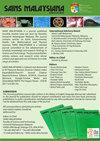昆虫病原真菌 Metarhizium Anisopliae(Hypocreales: Clavicipitaceae)对金苹果蜗牛 Pomacea Canaliculata(Architaeniglossa: Ampullariidae)的杀软体动物活性
IF 0.7
4区 综合性期刊
Q3 MULTIDISCIPLINARY SCIENCES
引用次数: 0
摘要
金苹果蜗牛(GAS,Pomacea canaliculata)在马来西亚被称为世界上最严重的入侵害虫物种之一,对稻田造成严重破坏,使水稻产量急剧下降。目前,农民使用化学杀软体动物剂来消灭 GAS,但这些杀软体动物剂价格昂贵,而且会对健康和环境造成严重影响。与化学杀软体动物剂相比,使用昆虫病原真菌的生物防治剂是控制禾谷类害虫的首选,因为它无毒、环保且成本效益高。本研究旨在调查一种昆虫病原真菌--Metarhizium anisopliae 对 GAS 成虫和虫卵的杀软体活性。随后,将 M. anisopliae 分生孢子制成四种浓度(3×104、3×105、3×106 和 3×107 分生孢子/毫升),并对 GAS 成虫和虫卵进行了测试。3×107 浓度的中位致死时间(LT50)分别需要 5 天和 3 天才能杀死 50%的 GAS 成虫和抑制 50%的虫卵孵化。还对 GAS 成虫和虫卵进行了生理分析。受感染个体的皮肤变白且不透明,肺囊、消化道和肝胰脏等内脏器官明显遭到破坏。恙虫病菌感染后,恙虫病卵的颜色变淡,导致卵无法存活。这项研究表明,M. anisopliae 是一种有效的蛆虫生物控制剂,有可能用作蛆虫管理的定向生物杀软体动物剂。本文章由计算机程序翻译,如有差异,请以英文原文为准。
Molluscicidal Activity of Entomopathogenic Fungus, Metarhizium Anisopliae (Hypocreales: Clavicipitaceae) Against Golden Apple Snails, Pomacea Canaliculata (Architaeniglossa: Ampullariidae)
Golden Apple Snails (GAS, Pomacea canaliculata) is known in Malaysia as one of the world's worst invasive pest species, wreaking havoc on paddy fields by lowering rice yield dramatically. Farmers now employ chemical molluscicides to eliminate GAS, but these are expensive and have serious health and environmental consequences. Biological control agent using entomopathogenic fungus is preferred over chemical molluscicides to control GAS because it is non-toxic, environmentally friendly and cost-effective. This study is aimed to investigate the molluscicidal activity of an entomopathogenic fungus, Metarhizium anisopliae towards GAS adults and eggs. M. anisopliae conidia were subsequently produced into four concentrations (3×104, 3×105, 3×106, and 3×107 conidia/mL) and tested against adults and eggs GAS. The median lethal time (LT50) for the concentration of 3×107 took 5 and 3 days to kill 50% of GAS adults and inhibited 50% of eggs from hatching, respectively. Physiological analysis was also conducted on both GAS adults and eggs. The skin of infected individuals became white and opaque, while internal organs such as the pulmonary sac, digestive tract, and hepatopancreas were visibly destroyed. The colour of GAS eggs turned pale after M. anisopliaeinfestation and resulted in non-viable eggs. This research shows that M. anisopliae is an effective biological control agent for GAS and has the potential to be used as a targeted bio-molluscicide for GAS management.
求助全文
通过发布文献求助,成功后即可免费获取论文全文。
去求助
来源期刊

Sains Malaysiana
MULTIDISCIPLINARY SCIENCES-
CiteScore
1.60
自引率
12.50%
发文量
196
审稿时长
3-6 weeks
期刊介绍:
Sains Malaysiana is a refereed journal committed to the advancement of scholarly knowledge and research findings of the several branches of science and technology. It contains articles on Earth Sciences, Health Sciences, Life Sciences, Mathematical Sciences and Physical Sciences. The journal publishes articles, reviews, and research notes whose content and approach are of interest to a wide range of scholars. Sains Malaysiana is published by the UKM Press an its autonomous Editorial Board are drawn from the Faculty of Science and Technology, Universiti Kebangsaan Malaysia. In addition, distinguished scholars from local and foreign universities are appointed to serve as advisory board members and referees.
 求助内容:
求助内容: 应助结果提醒方式:
应助结果提醒方式:


